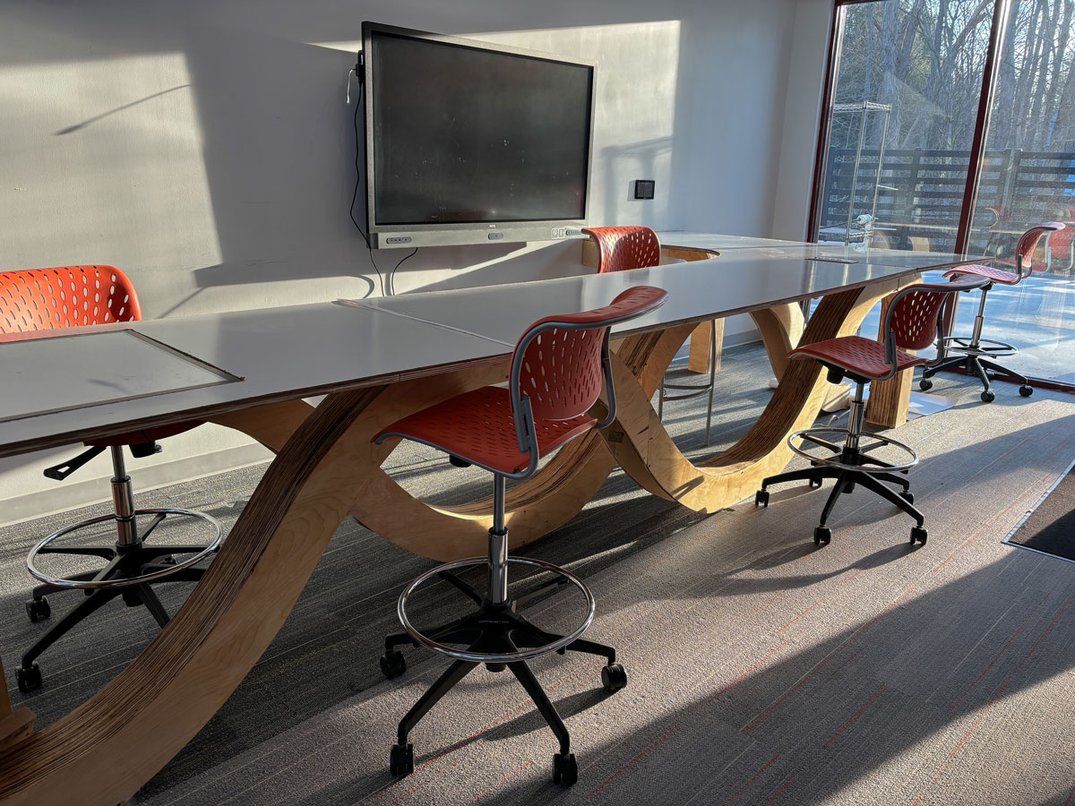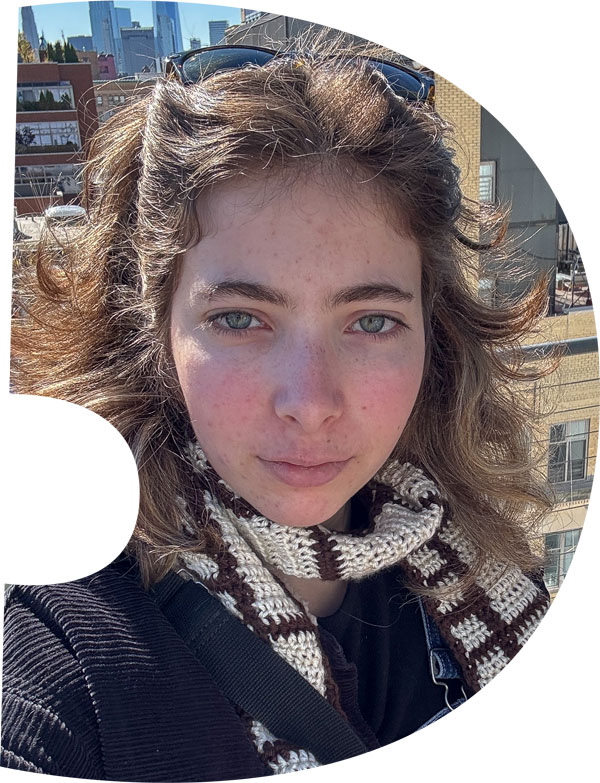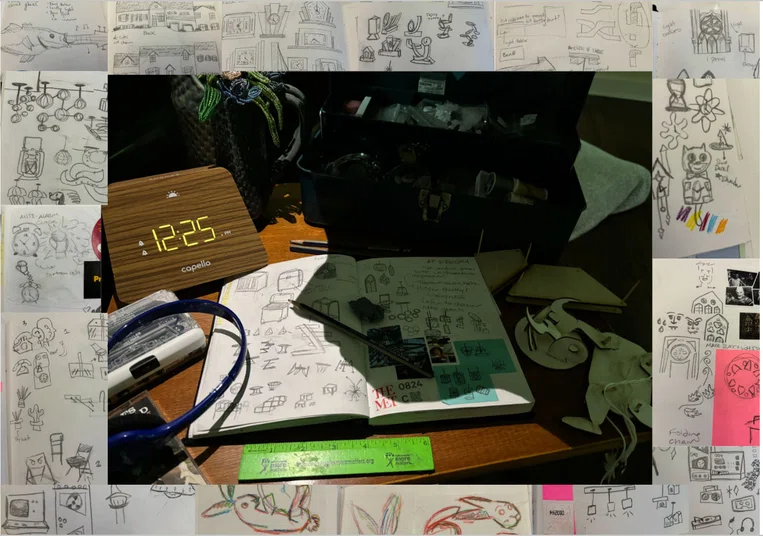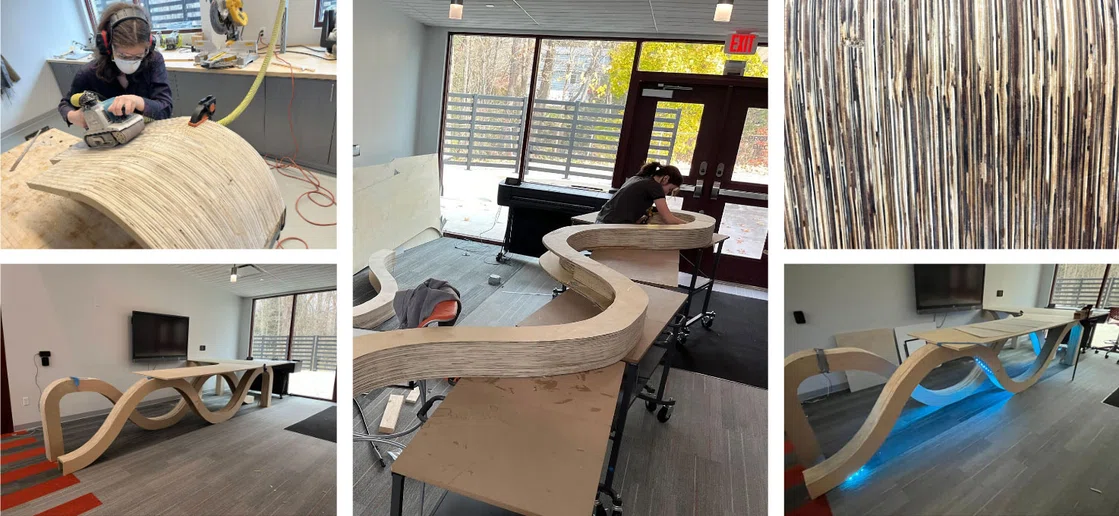

DNA Table and Making Habits

Height: 38" x Width: 185" x Depth: 80" | Material(s): Wood, whiteboard | Process(es): My DNA, helix shapes, added to the school's space, lasting forever. | Idea(s): Creating a unique table to fill a space in my school. It needed to be functionally collaborative. | Curatorial Note: This work of art that serves as a table is a very ambitious piece. The incorporation of the artist’s DNA helix shapes into the overall form is unique.
Kaitlyn Hare


Student statement
Student statement
Please describe the context for how the idea for this artwork originated (was this part of your sustained investigation, an independent project, a class assignment, created during a summer study, etc.).
The origin of the table was from being assigned to create a workspace for my peers. From there I was given full creative freedom to try anything I wanted. I started working on it in my junior year of high school and continued into my senior year. The self-portrait was made to highlight the process I took to sketch and develop my portfolio. I also wanted to demonstrate how a workspace can highlight personal identity and unintentionally reveal a great deal about an artist.
Does your work reference or draw on a contemporary or historical art-making style, practice, or tradition? If so, please explain.
My work consistently has some through line to historical styles I have a strong connection to. There are many different styles and eras that inspire my daily life, and I would often use that as a starting point to help with the creative process. I created mood boards based on these, which made me realize that looking back and observing art is incredibly important for designers to consider.

I tried a different approach to make the works quirky by using puns/phrases and interpreted them into art.
In what ways did you practice and experiment when developing your sustained investigation?
While developing this project, I always started small with proof of concepts and slowly added to the complexity. I practiced using equipment that I was not familiar with, such as a laser cutter, CNC router, and other shop machinery. The table was a huge undertaking because it was the largest thing by far that I had ever made (about 15 feet). My concept had no right angles in it, which is atypical for the structure I was making. Between those two challenges, I was faced with a plethora of issues and no choice but to work to find solutions. It created a ginormous learning curve that I had to overcome, which helped develop my skills tremendously. I had made a smaller table before, which helped inform me on how to go about the process. The goal I had in mind for my portrait was to show personality in my portfolio, something I had tried to do throughout my sustained investigation. This was a final piece to a collection that I wanted to make feel like a whole. It was important to me to show the steps and the tools I used to hone some of my skills. My sketches, cassette tapes that I listened to while working, and craft supply toolbox are all shown to give some insight into my process.
How did your materials and process(es) choices shape the creation or meaning of your artwork(s)?
For many years I considered the wood shop intimidating, which created a distance between me and the art form. When creating the table, I stepped out of my comfort zone to overcome any fears of the large machinery. Wood is also a material I find to be aesthetically pleasing, especially in its natural form. The table is organically shaped, so I wanted to create that connection with the material that I used. For my self-portrait, I wanted to experiment with light and shadow to create a balanced composition. I tried various ways of casting my profile onto my desk and eventually ended up laser cutting it to create a defined outline.

Material(s): Material(s): Mixed media | Process(es): My shadow, my desk. The isle of misfit projects, gone but not forgotten.
How did your art teacher support your artistic development?
My teacher Zach Arnold allowed me to experiment and develop many iterations of my projects. I would create prototypes, which I was able to present to my fellow peers for feedback and suggestions. He always gave thoughtful criticisms, which at times I didn’t want to hear because it could mean completely restarting a project. Unfortunately, I knew that he was always right. He was my teacher for multiple years, and he consistently had me try and find solutions independent of his help. This did cause me to make mistakes, but the frustration it caused created strong memories of what not to do in the future while creating designs. His constant support was what eventually led me to go to design school and pursue this as a career.
What is your advice to other AP Art and Design students?
The heaviest struggle that comes with building a successful portfolio is being able to manage time. My fellow peers and I definitely experienced the pressure of the impending deadline that was coming in May. Planning ahead and allocating time correctly are important skills that have to be considered while creating your various works. Deciding what needs more development and not stretching yourself too thin will help create a fully fleshed out final product. I admit I am a little hypocritical when saying this, because it is something I still am working on myself, but I acknowledge its importance. Creating a portfolio is an example of what it is like working with deadlines in the “real world,” so getting practice now will strongly aid you down the line.

Zach Arnold
Horace Greeley High School, Chappaqua, NY, USA
Teacher statement
Teacher statement
How did you support skill development AND inquiry in the AP Art and Design curriculum?
I try to help my students approach their art as a lifelong exploration, and I challenge them to seek out methods of expression that are new. Often, this requires them to stretch the limits of their expertise and to push the boundaries of comfortability. In Kaitlyn’s case, she had never built furniture and certainly nothing larger than a backpack when she started this work. Kaitlyn already showed skill in both drawing and designing on the laser cutter, so I asked her to think bigger. Can you take these skills and apply them with new materials, tools, and techniques at a radical new scale? She began by iterating in the small-scale world she knew, making toy-size models and then launching into skill acquisition and practice, learning new hand and machine tools. The result was a set of collaboration coffee tables that could be recomposed into a variety of shapes for different learning situations. After practicing at a medium scale, Kaitlyn addressed the large table. At this point, my instruction shifted from skills and techniques to inquiry, and we discussed how she should think about the “why” of the table and how she might balance the functionality she wanted to include (like electrical outlets, whiteboards, and a light table) with a form that spoke to her inquiry question and her style of mixing quirky designs with humor and unexpected compositions. Thus, a rounded, waterfall-edged, legless table was born— with wavy lines and colorful lighting underneath. Another way I tried to support Kaitlyn’s skill development and inquiry was to ask her to teach other students the techniques she had learned and to present her work to both individuals and groups. This helped her to build confidence in her abilities and made her continuously think about what she was making and why.
How did you structure practice, experimentation, and revision into your AP Art and Design curriculum?
Since students are all working at a different pace on their inquiry, I try to give opportunities for practice and experimentation where it naturally fits into their process. One thing I stress is that once a student has learned something, they should teach it to their peers. When it comes to experimentation, I’ll often have students look up innovative ideas they see online, practice replicating those techniques, and then reimagine it to be something completely new. In the design process, students start with brainstorming and sketching and then move to scaled models, which are minimally viable products. They rapidly and repeatedly test their ideas during the initial stages of development. Hand building, laser cutting, drawing, or sculpting, students use whatever is the most efficient way to find out if their idea will work. One of the advantages of having a large group of AP students is the access to peers from a wide variety of backgrounds. I ask students to do informal and formal presentations to different groups, including teachers, students, administration, and parents.
How do you support your students in the Selected Works portfolio component?
I think the most important thing you can give students is a space to work and time to explore it. I aim to offer this to my students by maintaining an open studio that they can access at any time throughout the school day to work on their projects. My department has also created shared production spaces for sculpture, fashion, drawing/painting, photo, digital work, and STEAM. Within these spaces, students can move freely, seeking feedback from a variety of teachers and peers with expertise in different disciplines.
What did you learn from working with your student?
Working with Kaitlyn was really inspirational for me as a teacher because she taught me to ignore any preconceived notions I had about what students are capable of. It was exciting to watch her grow as an artist as she pushed the limits of her thinking and skills. In the future, when a student wants to try something really challenging, I know to answer “yes” and then help them figure out the “how” later.
Kaitlyn Hare

